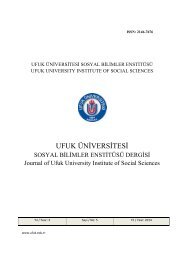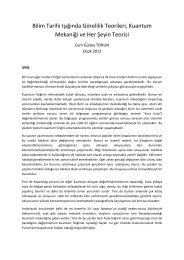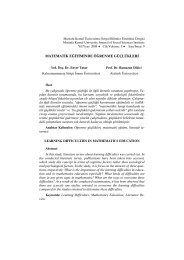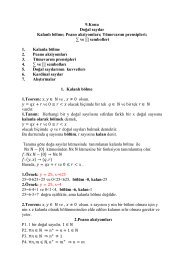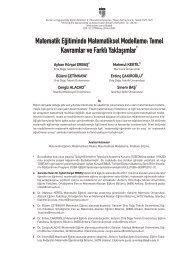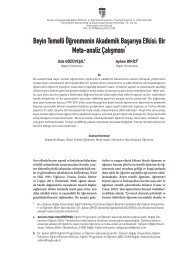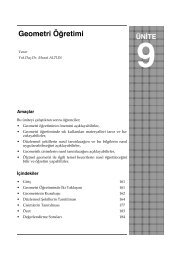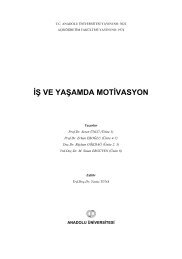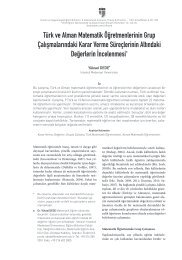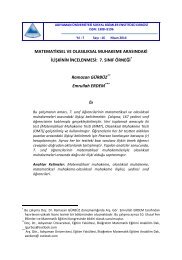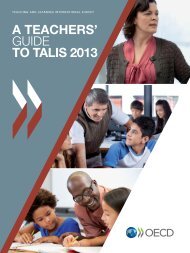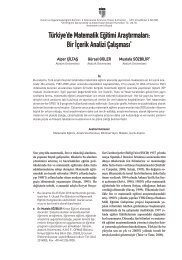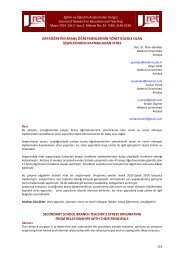NEWSLETTER
2015-12-98
2015-12-98
You also want an ePaper? Increase the reach of your titles
YUMPU automatically turns print PDFs into web optimized ePapers that Google loves.
Book Reviews<br />
Book Reviews<br />
David Hestenes<br />
Space-Time Algebra<br />
(second edition)<br />
Birkhäuser, 2015<br />
xxiv + 102 pages<br />
ISBN 978-3-319-18412-8<br />
Reviewer: Sebastià Xambó-Descamps<br />
The 6th Conference on Applied Geometric Algebras in<br />
Computer Science and Engineering 1 (AGACSE) was<br />
dedicated to David Hestenes (Arizona State University)<br />
in recognition of his masterly and sustained leadership<br />
for half a century, particularly at the interface of mathematics<br />
and physics. The dedication was celebrated with<br />
the launch 2 of a second edition of his Space-Time Algebra<br />
(Gordon and Breach, 1966). David was present during the<br />
whole week and the standing ovation after his keynote lecture,<br />
3 culminating in his recitation of the stirring call to action<br />
from Tennyson’s Ulysses, 4 was a very moving moment<br />
for all participants. The David Hestenes Prize was established<br />
for the best work submitted by a young researcher<br />
and was awarded to Lei Huang (Academy of Science,<br />
Beijing, China) for “Elements of line geometry with geometric<br />
algebra”. 5 His work shows how to bring the power<br />
of geometric algebra to bear on 3D projective geometry,<br />
thus linking new mathematical theory with very practical<br />
applications in computer science. Pierre-Philippe Dechant<br />
(University of York, UK) and Silvia Franchini (University<br />
of Palermo, Italy) were finalists with the works “The E 8<br />
geometry from a Clifford perspective” and “A family of<br />
David Hestenes (July 2015,<br />
during his keynote lecture).<br />
1<br />
AGACSE 2015, 27–31 July, Barcelona, Spain: http://wwwma2.upc.edu/agacse2015/<br />
2<br />
Suggested as an 80th birthday gift by Leo Dorst, cooperatively<br />
backed by Eduardo Bayro-Corochano, Joan Lasenby,<br />
Eckhard Hitzer and the author of this review, and enthusiastically<br />
embraced by Springer, each participant received a<br />
copy by courtesy of the Catalan Mathematical Society and<br />
the Royal Spanish Mathematical Society.<br />
3<br />
Fifty Years with Geometric Algebra: a retrospective.<br />
4<br />
“Made weak by time and fate, but strong in will / To strive, to<br />
seek, to find, and not to yield” (last two verses).<br />
5<br />
Joint work with Hongbo Li, Lei Dong, and Changpeng Shao.<br />
From left to right: David Hestenes, Lei Huang, Silvia Franchini,<br />
Pierre-Philippe Dechant, Sebastià Xambó-Descamps, Eduardo<br />
Bayro-Corrochano.<br />
embedded coprocessors with native geometric algebra<br />
support”, 6 respectively. The conference was preceded, for<br />
the first time, by a 2-day Summer School to better prepare<br />
the less experienced and it was attended by two thirds of<br />
the conference participants. The next AGACSE will be in<br />
Campinas, Brazil, in 2018.<br />
Space-Time Algebra (STA) is actually a reprint of the<br />
first edition, but with two precious new items: a foreword<br />
by Anthony Lasenby 7 and a preface by the author “after<br />
fifty years”. It was a landmark in 1966 and it is as fresh<br />
today as it was then in its “attempt to simplify and clarify<br />
the [mathematical] language we use to express ideas<br />
about space and time”, a language that “introduces novelty<br />
of expression and interpretation into every topic”<br />
(the quotations are from the preface to the first edition).<br />
This language is usually called geometric algebra (GA),<br />
a term introduced by W. K. Clifford in his successful synthesis<br />
of ideas from H. Grassmann and W. R. Hamilton.<br />
In Part I of STA, GA is advanced and honed into a resourceful<br />
mathematical system capable of expressing<br />
geometric and physical concepts in an intrinsic, efficient<br />
and unified way. Two special cases are worked through<br />
in detail: the geometric algebras of 3D Euclidean space<br />
(Pauli algebra) and 4D Minkowski space 8 (Dirac algebra).<br />
These geometric algebras are then used, in a real<br />
tour-de-force, to elicit the deep geometric structure of<br />
relativistic physics. This takes the remaining four parts<br />
of the book: Electrodynamics, Dirac fields (including<br />
spinors and the Dirac equation), Lorentz transformations<br />
and Geometric calculus (including novel principles<br />
of global and local relativity, gauge transformations and<br />
spinor derivatives). There are also four short appendixes,<br />
6<br />
Co-authored by Antonio Gentile, Filippo Sorbello, Giorgio<br />
Vassallo and Salvatore Vitabile.<br />
7<br />
Professor of Astrophysics and Cosmology at the Cavendish<br />
Laboratory, Cambridge University. Co-author of the superb<br />
treatise [1].<br />
8<br />
A real vector space with a metric of signature (+, –, –, –).<br />
EMS Newsletter December 2015 63




